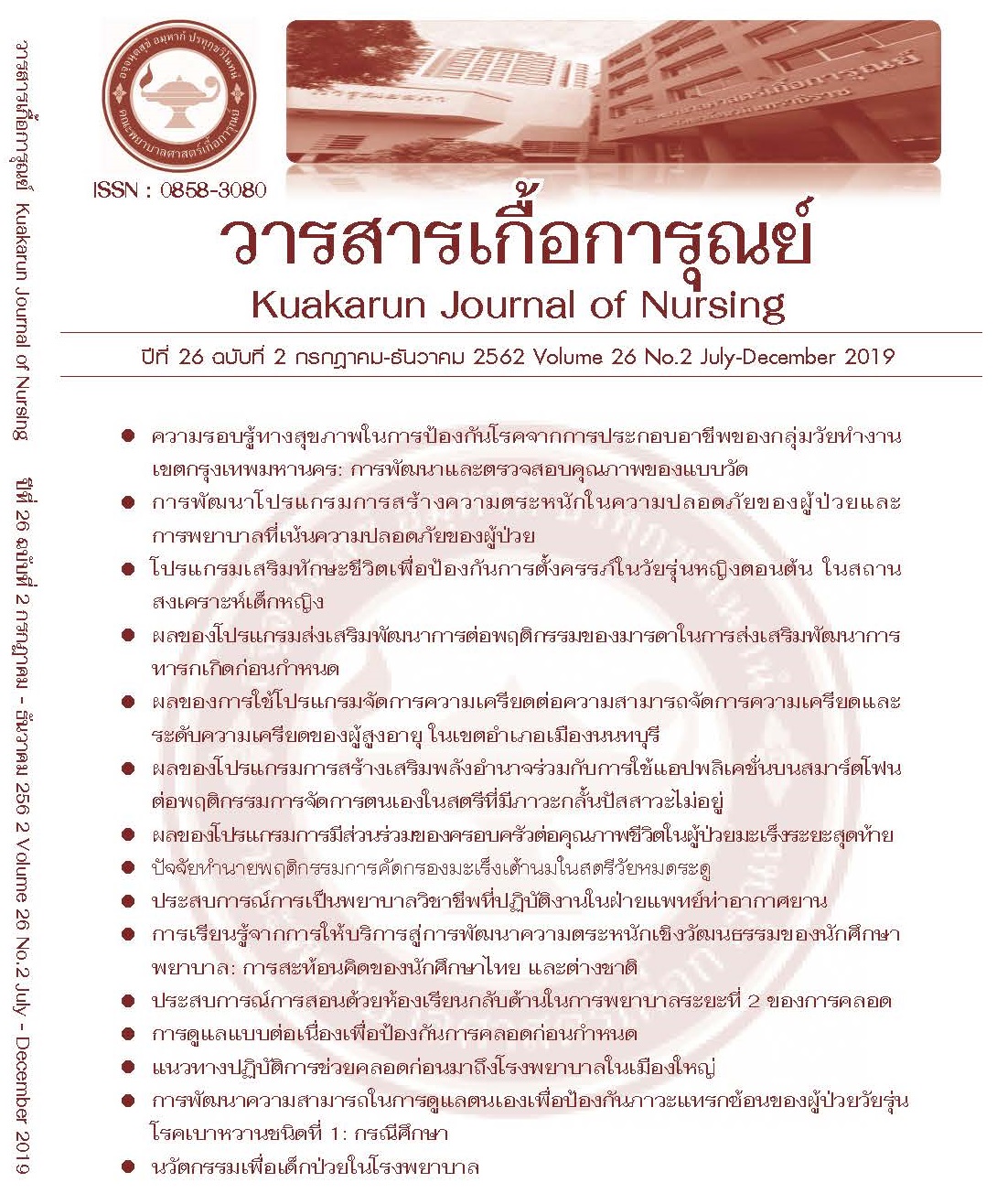การพัฒนาโปรแกรมการสร้างความตระหนักในความปลอดภัยของผู้ป่วยและพัฒนาการพยาบาลที่เน้นความปลอดภัยของผู้ป่วย
คำสำคัญ:
ความตระหนักของพยาบาล, ความปลอดภัยผู้ป่วย, การเรียนรู้สู่การเปลี่ยนแปลงบทคัดย่อ
การวิจัยครั้งนี้เป็นการวิจัยและพัฒนามีวัตถุประสงค์เพื่อสร้างและออกแบบ รวมทั้งทดสอบประสิทธิภาพและประสิทธิผลของโปรแกรมการสร้างความตระหนักในความปลอดภัยของผู้ป่วยและพัฒนาทักษะการพยาบาลที่เน้นความปลอดภัยของผู้ป่วย กลุ่มตัวอย่างเป็นพยาบาลวิชาชีพ จำนวน 80 คน เลือกกลุ่มตัวอย่างแบบเจาะจง แบ่งเข้ากลุ่มทดลอง 40 คน และกลุ่มควบคุม 40 คน เครื่องมือที่ใช้ในการวิจัย ได้แก่ แบบประเมินความต้องการจำเป็น แนวคำถามการสัมภาษณ์เชิงลึก แผนกิจกรรมตามโปรแกรมแบบวัดตัวแปรได้ตรวจสอบความเที่ยงตรงเชิงเนื้อหา และมีค่าความเชื่อมั่นระหว่าง .82 - .91 วิเคราะห์ข้อมูลด้วยสถิติทดสอบคา่เฉลี่ยของกลุ่มตัวอย่าง 1 กลุ่ม สถิติทดสอบค่าเฉลี่ยระหว่างกลุ่ม และสถิติความแปรปรวนทางเดียวแบบวัดซ้ำ
ผลการวิจัยระยะที่ 1 พบว่า โปรแกรมที่พัฒนาขึ้น ประกอบด้วย 1) การพัฒนาความตระหนักเกี่ยวกับความปลอดภัยในสถานการณ์ที่เร่งรีบ 2) ทักษะส่งต่อข้อมูลระหว่างวิชาชีพและการสื่อสารกับผู้ป่วยและญาติ และ 3) ทักษะแก้ไขปัญหาเฉพาะหน้าได้อย่างมีประสิทธิภาพ และผลการวิจัยระยะที่ 2 พบว่า โปรแกรมที่สร้างขึ้นมีความเหมาะสมและมีประสิทธิภาพเป็นไปตามเกณฑ์ E1/ E2 = 88.18/ 89.74 และกลุ่มทดลองมีความตระหนักต่อความปลอดภัยของผู้ป่วยสูงกว่ากลุ่มควบคุม อย่างมีนัยสำคัญทางสถิติที่ระดับ 0.01 และกลุ่มทดลองมีความตระหนักต่อความปลอดภัยของผู้ป่วยทั้งหลังทดลองและระยะติดตามผล สูงกว่าก่อนทดลองอย่างมีนัยสำคัญทางสถิติที่ระดับ .01
เอกสารอ้างอิง
ชนัดดา ภูหงส์ทอง. (2561). การเรียนรู้สู่การเปลี่ยนแปลง: ความท้าทายของผู้สอนในระดับอุดมศึกษา. วารสารพฤติกรรมศาสตร์, 24(1), 163 – 182.
วีณา จิระแพทย์, และเกรียงศักดิ์ จิระแพทย์. (2550). การบริหารความปลอดภัยของผู้ป่วย : แนวคิด กระบวนการและแนวปฏิบัติความปลอดภัยทางคลินิก. กรุงเทพมหานคร: ด่านสุทธาการพิมพ์.
สนิท พร้อมสกุล, สมใจ พุทธาพิทักษ์ผล และ กฤษดา แสวงดี. (2554). ปัจจัยที่มีอิทธิพลต่อภาวะสุขภาพของพยาบาลวิชาชีพในสถานบริการสุขภาพภาครัฐ เขตตรวจราชการสาธารณสุขที่ 17. การประชุมเสนอผลงานวิจัยระดับบัณฑิตศึกษา มหาวิทยาลัยสุโขทัยธรรมาธิราช ครั้งที่ 1 วันที่ 26 สิงหาคม 2554.
สลินลา สิงห์พันธ์. (2561). บทสัมภาษณ์ การช่วยเหลือเบื้องต้นแก่ผู้รับบริการตามมาตรา 41 ณ วันที่ 17 สิงหาคม 2561 เข้าถึงจาก https://www.nhso.go.th/ARCHIVES/section5/detail5.aspx วันที่ 31 เมษายน 2562.
สาหร่าย จันสา. (2560) อิทธิพลของการสื่อสารที่มีประสิทธิภาพและการทำงานเป็นทีมต่อการจัดการด้านความปลอดภัยของพยาบาลวิชาชีพที่ปฏิบัติงานหอผู้ป่วยในโรงพยาบาลรัฐบาลแห่งหนึ่งในกรุงเทพมหานคร วารสารพยาบาลทหารบก, 18[ฉบับพิเศษ], 299 -307
สุรีรัตน์ รัตนสำเนียง. (2555). ความตระหนักด้านความปลอดภัยในการปฏิบัติงานของพยาบาลและ การสร้างความตระหนักด้านความปลอดภัยในการปฏิบัติงานของหัวหน้าหอผู้ป่วยตามการรับรู้ของพยาบาลวิชาชีพโรงพยาบาลทั่วไปภาคใต้. สารนิพนธ์พยาบาลศาสตรมหาบัณฑิตสาขาการบริหารการพยาบาลมหาวิทยาลัยสงขลานครินทร์, สงขลา.
Hein, S. F. (2004). Embodied reflexivity in qualitative psychological research: The disclosive capacity of the lived body. In advances in psychology research, Volume 30. Edited by S. P. Shohov (Ed.), pp. 57-74. New York: Nova Science.
Mezirow, J. (2000). Learning as transformation: Critical perspectives on a theory in progress. San Francisco: Jossey-Bass.















